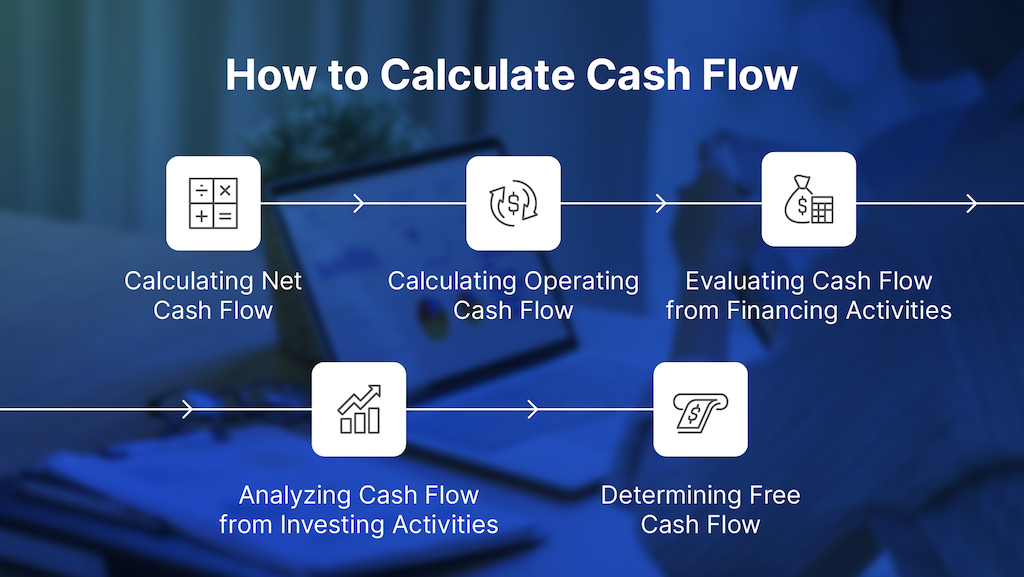In the first part of our Cash Flow series, we’ve explored the basics about cash flow in What is Cash Flow, Types of Cash Flows & Its Significance for Businesses. As a summary, cash flow is the movement of money into and out of your business over a specific period, encompassing not only revenue but also expenses, investments, and loans. It is important to effectively manage your company’s cash flow because it helps you determine your business’s financial position and ensure that your operations can run smoothly.
The next step in this journey is to learn how to calculate cash flow and to be able to make cash flow projections for your business. Let’s get started!
How to Calculate Cash Flow
A. Calculating Net Cash Flow
Net cash flow is a key indicator of your company’s financial health. It represents the difference between all the cash inflows and cash outflows in a given period. By calculating net cash flow, you can get a clear picture of how much money your business is generating or losing.
Use the following formula to calculate net cash flow:
Net Cash Flow = Total Cash Inflows – Total Cash Outflows
Let’s illustrate this with an example. Suppose Company A had a total cash inflow of $150,000 and a total cash outflow of $100,000. Using the formula, we can calculate the net cash flow:
Cash Inflow ($150,000) – Cash Outflow ($100,000) = Net Cash Flow ($50,000)
Balancing cash inflow and outflow is vital to maintaining a healthy business.
B. Calculating Operating Cash Flow
Operating cash flow (OCF) provides insights into your company’s ability to generate cash from its normal operations. It focuses solely on the cash generated from day-to-day business operations, so cash flows from financing and investing activities are excluded.
To calculate operating cash flow, use the following formula:
Operating Cash Flow = Net Income + Non-Cash Expenses – Change in Working Capital
Net income represents the profit generated by your business, while non-cash expenses include items like depreciation and amortization. Change in working capital reflects the difference between your current assets and liabilities.
Let’s consider an example for better understanding. Company B had a net income of $250,000, non-cash expenses of $100,000, and a change in working capital of $50,000. Using the formula, we can calculate the operating cash flow:
Net Income ($250,000) + Non-cash Expenses ($100,000) – Change in Working Capital ($50,000) = Operating Cash Flow ($300,000)
Operating cash flow is a critical metric for assessing your business’s ability to generate cash from its core operations.
C. Evaluating Cash Flow from Financing Activities
Cash flow from financing activities (CFF) measures the net flow of cash between your company and its owners, creditors, and investors. It provides insights into your company’s financing mix and its ability to raise capital.
To calculate cash flow from financing activities, use the following formula:
Cash Flow from Financing Activities = Cash Inflows From Issuing Equity or Debt – (Dividends Paid + Repurchase of Debt and Equity)
Cash inflows from issuing equity or debt refers to the money your company receives from issuing stocks or taking on debt. On the other hand, dividends paid and repurchase of debt and equity are the cash outflows in this case.
Let’s consider an example. Company C had cash inflows of $150,000 from issuing equity or debt, paid dividends of $20,000, and made a repurchase of debt and equity of $50,000. Using the formula, we can calculate the cash flow from financing activities:
Cash Inflows from Issuing Equity or Debt ($150,000) – (Dividends Paid ($20,000) + Repurchase of Debt and Equity ($50,000)) = Cash Flow from Financing Activities ($80,000)
Cash flow from financing activities provides insights into how your company raises and distributes funds.
D. Analyzing Cash Flow from Investing Activities
Cash flow from investing activities (CFI) measures the net cash inflow or outflow resulting from capital expenditures, mergers and acquisitions, and the purchase or sale of marketable securities. It helps you understand how your company is investing its cash.
To calculate cash flow from investing activities, use the following formula:
CFI = Cash Inflows from Investing Activities − Cash Outflows from Investing Activities
These items can be found in your cash flow statement or by comparing non-current assets on your balance sheet over two periods.
Let’s consider an example. Company D had a purchase of property and equipment of $50,000, a purchase of other businesses of $75,000, and a sale of marketable securities of $25,000. Using the formula, we can calculate the cash flow from investing activities:
Purchase of Property and Equipment ($50,000) – Purchase of Other Businesses ($75,000) + Sale of Marketable Securities ($25,000) = Cash Flow from Investing Activities ($150,000)
Let’s consider an example. Company D receives $50,000 from a sale of equipment, and receives another $50,000 as part of an acquisition. Company D also paid $20,000 for investment in marketable securities. Using the formula, we can calculate the cash flow from investing activities:
Cash Inflows from Investing Activities ($50,000 + $50,000) − Cash Outflows from Investing Activities ($20,000) = Cash Flow from Investing Activities ($80,000)
Cash flow from investing activities provides insights into how your company is allocating its funds for long-term growth and investment.
E. Determining Free Cash Flow
Free cash flow (FCF) represents the cash left over after your business has met all its obligations. It’s the cash that your business has available for growth, expansion, or distributing to shareholders. Calculating free cash flow helps you understand your company’s financial flexibility.
To calculate free cash flow, use the following formula:
Free Cash Flow = Net Income + Non-Cash Expenses – Change in Working Capital – Capital Expenditure
Net income represents your company’s profit, non-cash expenses include items like depreciation and amortization, change in working capital reflects the difference between your current assets and liabilities, and capital expenditure represents the money spent on acquiring or maintaining fixed assets.
Let’s consider an example. Company E had a net income of $200,000, non-cash expenses of $100,000, a change in working capital of $125,000, and a capital expenditure of $50,000. Using the formula, we can calculate the free cash flow:
Net Income ($200,000) + Non-cash Expenses ($100,000) – Change in Working Capital ($125,000) – Capital Expenses ($50,000) = Free Cash Flow ($125,000)
Free cash flow provides a measure of your company’s financial strength and its ability to pursue growth opportunities.
Creating Cash Flow Projections
A. Reasons Why You Should Create Projections
Cash flow projections are essential tools for managing your business’s financial health. They involve forecasting future cash inflows and outflows based on historical data and anticipated changes. Here’s why it’s imperative for you to create cash flow projections:
- Anticipating Shortfalls: Projections help you identify periods when your business might experience cash shortages, allowing you to plan for solutions in advance.
- Making Informed Decisions: With projections in hand, you can make strategic decisions about when to invest, expand, or cut expenses while considering their impact on your cash flow.
- Demonstrating Financial Health: Lenders and investors often require cash flow projections to assess the financial stability and growth potential of your business.
B. Steps to Create Cash Flow Projections
- Gather Historical Data: Start by collecting past financial statements and cash flow data. This will serve as the foundation for your projections.
- Identify Key Assumptions: Outline the assumptions that will drive your projections, including sales growth rates, expense trends, and anticipated cash inflows from various sources.
- Create Monthly Projections: Develop cash flow projections on a monthly basis for the upcoming year or longer, depending on your business’s needs.
- Monitor and Adjust: Regularly compare your actual cash flow to your projections. If discrepancies arise, adjust your forecasts accordingly to reflect the evolving financial landscape.
C. Example Cash Flow Projections
Let’s consider an example: A small manufacturing business in Indonesia wants to create cash flow projections for the next year. They start by gathering historical data on sales, expenses, and cash flows. Using this data, they project monthly cash inflows from sales, anticipate expenses, and factor in loan repayments and interest payments.
These projections help the business identify potential cash shortfalls during peak production months and plan to secure a short-term working capital loan to cover these periods. Additionally, they can evaluate the impact of increasing sales or reducing expenses on their cash flow.
By creating and regularly updating cash flow projections, businesses can proactively manage their finances, minimize cash flow issues, and make informed decisions to support growth and stability.We hope that the above has given you the tools you need to calculate the different types of cash flow and make projections for your company. In our next and last installment, we bring you a comprehensive guide on Cash Flow Management, How to Manage, Tips & Challenges.










